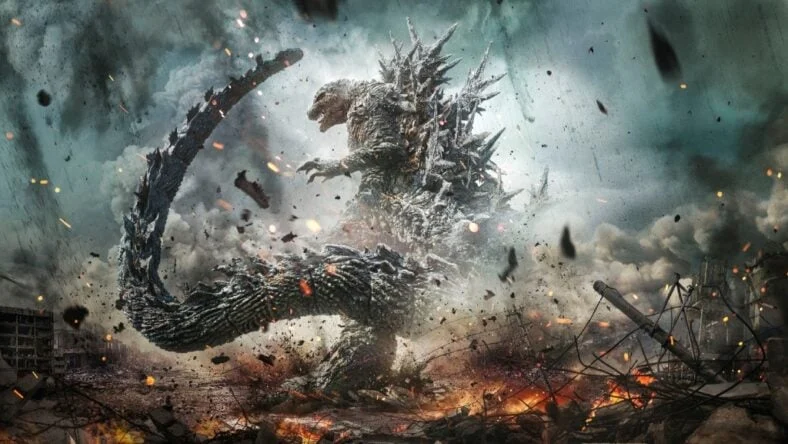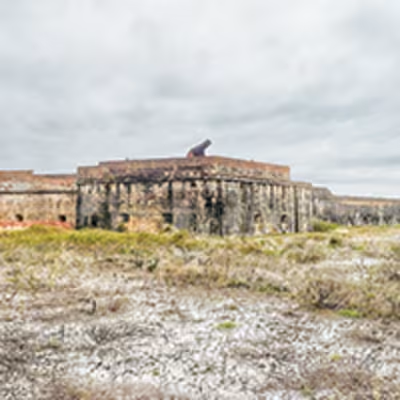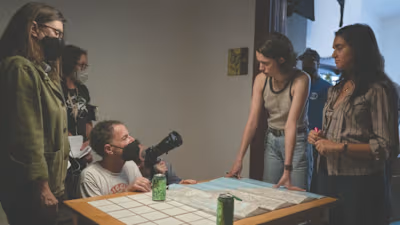Takashi Yamazaki on the ‘Striking’ Connection Between Godzilla …

A still from Godzilla Minus One
Set in the ruins of post-World War II Tokyo, Takashi Yamazaki’s Godzilla Minus One introduces the famous lizard monster as a new crisis baptized in the horrific power of the atomic bomb. And while he says it was “definitely a coincidence” that it came out in the same year as Christopher Nolan’s Oppenheimer, about the father of the atomic bomb, the director can’t help but acknowledge their striking similarities — and the relevance they share.
“I think the threat of nuclear warfare is almost at its highest right now in recent years than in any other year that most of us have been alive. And in some ways, the original 1954 Godzilla was created with that same backdrop in the wake of World War II, asking what it means for these superpowers to develop so many nuclear warheads,” Yamazaki told MovieMaker.
“I think the fear and threat of it is certainly real, but the timely relevance of the thematic elements are quite striking.”
Godzilla Mins One finds a group of ragtag veterans come together to do what their country can’t and end the threat once and for all. Actor Ryunosuke Kamiki leads the Japanese ensemble of actors as Koichi Shikishima, a failed Kamikaze pilot in search of redemption wherever he can find it.
Legendary’s ongoing MonsterVerse series of movies and TV featuring the green-scaled baddie hasn’t stopped audiences from flocking to see the Japanese-produced Godzilla Minus One since it landed on American shores in early December. It’s collected over $50 million at the domestic box office so far, making it one of the most successful Japanese-language movies of all time.
Director Takashi Yamazaki tells MovieMaker that he considers Godzilla Minus One “a culmination of my entire filmography and everything I’ve been building up this entire time.” His career started in 1986 when he joined Shirogumi in Setagaya City. There he honed his skills as a visual effects supervisor, and later he created popular features like The Twilight Samurai and Lupin III: The First.
And on Tuesday morning, Yamazaki became the first director since Stanley Kubrick (for 2001: A Space Odyssey) to be nominated for the Best Achievement in Visual Effects Academy Award. In turn, Oppenheimer was nominated for no less than 13 Oscar nominations including Best Picture.
We spoke with Yamazaki about using his background in special effects to blend emotional performances with practical effects in Godzilla Minus One. The Japanese auteur talks about the length he went to watch Christopher Nolan’s Oppenheimer and how the upcoming Godzilla Minus One Minus Color, in theaters on January 26, is different from his original theatrical release.
Godzilla Minus One Director Takashi Yamazaki Q&A
Joshua Encinias: Have you felt the rush from Godzilla Energy Chu-hi?
Takashi Yamazaki: [Laughs.] I drank a sample and I do recall it packed a punch.
Joshua Encinias: Is it just a coincidence that Godzilla Minus One and Christopher Nolan’s Oppenheimer were released the same year?
Takashi Yamazaki: It was definitely a coincidence that both films came out this year. But in a much more relevant sense to current events, I think the threat of nuclear warfare is almost at its highest right now in recent years than in any other year that most of us have been alive. And in some ways, the original 1954 Godzilla was created with that same backdrop in the wake of World War II, asking what it means for these superpowers to develop so many nuclear warheads. I think the fear and threat of it is certainly real but the timely relevance of the thematic elements are quite striking.
Joshua Encinias: Did you see Oppenheimer? What did you think of its perspective?
Takashi Yamazaki: I actually wanted to see Oppenheimer so bad but it’s yet to receive a theatrical release in Japan. But because I wanted to see it so badly, I flew to Taiwan and watched it with Chinese subtitles. With that said, my English, of course, is not that great. I don’t think I fully understood the nuance of what was happening in the film. But despite that, I did feel this very powerful force of what the film represented. And of course, being of Japanese descent and heritage, I’ve seen a lot more nukes in our pop culture or surroundings since I was really young. I feel that as a filmmaker and director, I do want to provide some kind of answer or response to Oppenheimer someday. I don’t think Godzilla is necessarily a direct response to it, although they point at similar themes. But even if this film is never realized, I think having it in the corner of my head as a strong thematic element is important.
Joshua Encinias: Much has been said about the movie’s budget. First, it was said to be $15 million, and later you said it was lower. What were some of the creative solutions you used to give the movie high production values despite its small budget?
Takashi Yamazaki: I want to say in Toho’s defense, the budget was less than $15 million, but that’s a pretty high-budget film for Japanese production standards.
We employed a lot of methods that we’ve used in the past with our VFX studio Shirogumi. We combined different techniques to create this illusion of reality. Anytime we have humans in a shot, we built out a practical set, however small, immediately surrounding the people. We extend whatever it is that’s happening in their environment using CG and green screens. So for example, we have a parking lot where we built out a small set and then painted the entire city in the background. Instead of using pressurized hydraulic cylinders to move the set during boat scenes, we had a stationary set and the actors moved in unison to act like they were rocking on a boat.
It’s a very retro style of capturing performance on screen and had we only used those techniques, I think it would not have been convincing. Employing these types of techniques using CG in as many places as possible while having practical sets around the human cast is what allowed us, I think, to create a very convincing picture.
Joshua Encinias: Your Godzilla in Minus One is a variation of the one you created for Godzilla the Ride. How is he different in the movie?
Takashi Yamazaki: He’s totally a CG creation and we really loved the ride version after it was complete — the team members who worked on it as well as the Godzilla fans. It was a very convincing and good interpretation of Godzilla. So while we did do some design exploration, we ultimately settled on using the one from the ride as a foundation. But we had to increase the level of detail when we were scaling up the model, no pun intended, because it required much higher resolution to handle some of the shots we wanted to do in the film. So it looks a lot sharper and more pointy in some ways than the version you see in the ride.
Joshua Encinias: When you have a character as famous as Godzilla, and you make a human-centered story like Godzilla Minus One, how do you keep the monster from overshadowing your actors?
Takashi Yamazaki: Our goal from the onset of this project was to make sure that we had a very strong human story and character development arc that the audience and fans could invest themselves in. I think it’s a tendency in a lot of Kaiju movies, because the nature of kaiju being so big, that the drama feels very disconnected and separated from what’s happening to the humans. The focus will go towards the Kaiju, which I think tends to happen in a lot of other movies. So we wanted to think about how we can close the distance between what the Kaiju is doing and the human drama. We wanted every audience member to get emotionally invested in some angle of the human drama component, which made what Godzilla was doing feel ever more real.
Joshua Encinias: Shikishima (Ryunosuke Kamiki) rebuilds his parent’s home after it was destroyed during the bombing of Tokyo. Will you talk about the significance of his keeping its broken gate?
Takashi Yamazaki: For Shikishima, I imagine he kept the gate because it was a piece of his past, of his own house, that represented proof of his hometown that has now been raised as a result of the airstrikes. But from a filmmaking perspective, it served as an anchor. It’s a part of the house that didn’t change, even though we see the evolution of Shikishima’s life in addition to how Japan was recovering from the aftermath. And as the home becomes more and more impressive, that one piece remaining unchanged helps the audience see the gap of how far he has come.
Joshua Encinias: How do you feel about the Westernization of Godzilla?
Takashi Yamazaki: The 1998 Godzilla was fairly well put together and a fun film, but I can understand the people who also say this isn’t Godzilla. I think as a Kaiju-horror type of film, it is quite well executed. And to their credit, I think it was the first time Godzilla was rendered in a digital context and methodology, so that was a huge achievement for its time. Ann with respect to Legendary’s Godzilla franchise, I think what those films have done is really explore the diversity and different takes you can see through the world and IP of Godzilla. The adaptability, if you will. If you look at more recent Toho or Japanese Godzilla films, Shin Godzilla and Godzilla Minus One, there’s a very serious, almost darker tone and theme being explored. But at the same time, the fact that Hollywood/Legendary’s Godzilla can coexist and take a very different interpretation for Godzilla shows how developed and diverse the IP or franchise can be.
Joshua Encinias: What does the upcoming release of Godzilla Minus One/Minus Color do that the original theatrical release does not?
Takashi Yamazaki: I think the information that color carries is quite interesting. By reducing this layer or dimension, it made the film feel as though the events we’re watching actually happened. It had this very interesting, almost documentary-type of feel. As we were producing the Minus Color version, even the team members working on it felt a different sense of fear, especially in the scenes that take place at night. I would argue that Minus Color brings a completely different emotion out of the audience and is a different movie in some respect. It contains a different set of information than Minus One does. So if you watch both, I think you’ll see the intent at a much different resolution than having only watched one version.
Main Image: A still from Godzilla Minus One
Like this project
Posted Jan 29, 2024
Godzilla Minus One director Takashi Yamazaki discusses the relevance between his monster movie and Oppenheimer concerning the atomic bomb
Likes
0
Views
21





